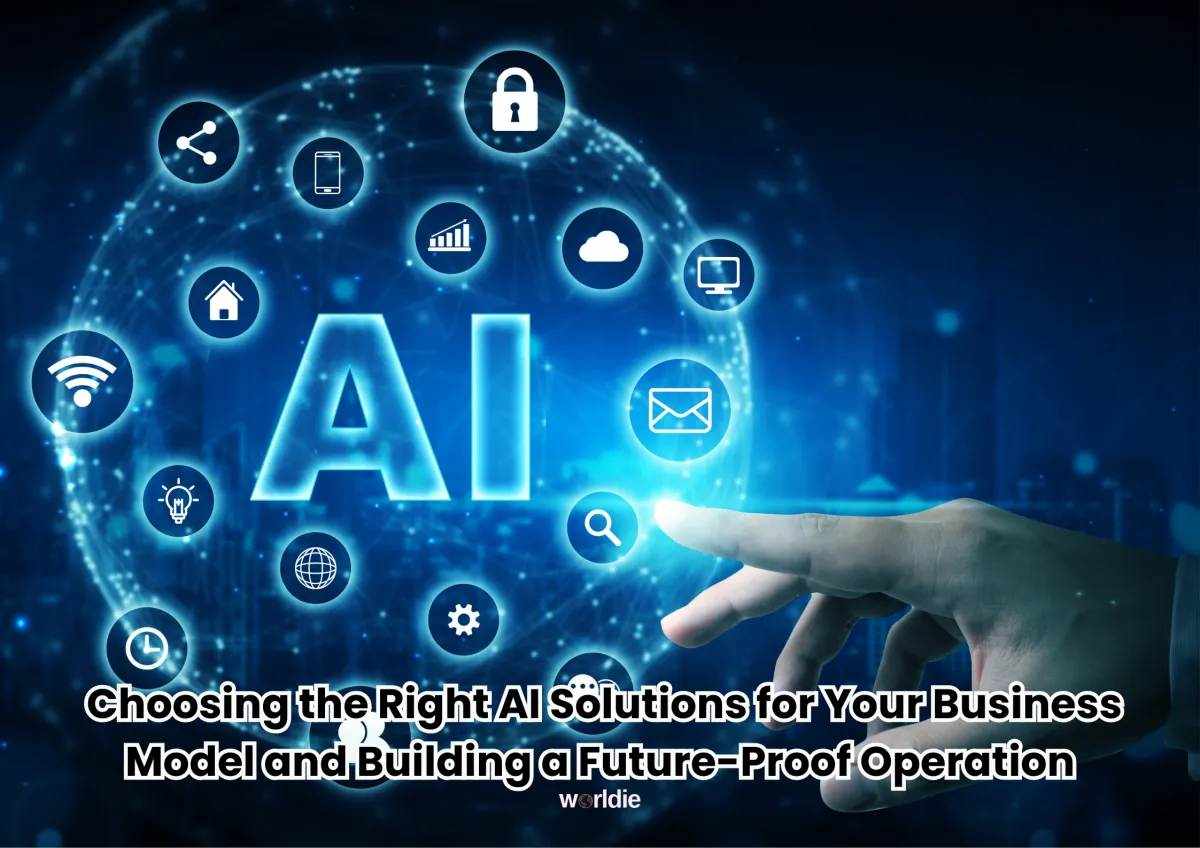
Choosing the Right AI Solutions for Your Business Model and Building a Future-Proof Operation
Choosing the right AI solutions for your business model isn’t about keeping up with technology trends — it’s about aligning intelligence, automation, and scalability with the unique DNA of your operations. The wrong AI strategy can waste resources, confuse teams, and stall transformation. The right one can turn data into predictive power, decisions into automated actions, and operations into a scalable growth engine.
Worldie AI works at this intersection — where strategy meets execution — helping businesses design, build, and release integrated AI ecosystems that directly drive revenue and efficiency.
The Strategic Importance of Choosing the Right AI Solutions
The global race toward AI adoption has created a flood of tools, platforms, and promises. But not every AI solution fits every business. When leaders select tools without understanding their alignment to core objectives, they risk fragmenting systems, duplicating processes, and generating inconsistent results.
Choosing the right AI solution begins with understanding your own business architecture. If your model depends on recurring revenue, for example, predictive analytics and churn modeling may offer the highest return. For a manufacturing firm, computer vision for quality assurance or predictive maintenance could yield more value. The most successful companies don’t chase AI trends — they design intelligent infrastructures tailored to their strategic outcomes.
What “Choosing the Right AI Solutions for Your Business Model” Really Means
Many organizations interpret “AI solution” as a singular tool that automates one task. In reality, AI is a layered ecosystem of technologies — from data pipelines and natural language models to intelligent automation systems.
The right AI solution should fit the operational rhythm of your organization. It must speak to your workflows, decision-making needs, and data maturity level. A startup might require AI to streamline repetitive admin tasks, while an enterprise might need cross-departmental intelligence that connects CRM, ERP, and marketing systems.
True alignment happens when your AI systems act as an extension of your business logic — not an isolated add-on.
Common Inefficiencies in Modern Business Operations
Modern organizations often suffer from operational friction caused by disconnected tools, inconsistent data, and human-dependent workflows. These inefficiencies multiply as companies scale.
When sales, marketing, and operations work from different data sources, it leads to decisions made in silos. Manual data entry and redundant approval flows slow down productivity. Teams spend time reconciling information instead of acting on insights.
These inefficiencies create blind spots that prevent leaders from understanding customer behavior, forecasting demand, or allocating resources effectively. AI, when properly aligned, eliminates these barriers by creating unified intelligence — where every system and decision draws from a consistent, data-driven foundation.
The Business Case for Intelligent AI Alignment
AI alignment isn’t just a technical decision; it’s a financial one. Businesses that match their AI investments to their operating models see higher efficiency, more predictable revenue, and improved margins.
For example, a retail brand that integrates AI into its inventory system can reduce overstocking and understocking. A B2B SaaS company using AI for lead scoring and customer health monitoring can increase renewals and lifetime value. These use cases illustrate a broader truth — when AI is purpose-built for your model, it becomes a multiplier of existing strengths rather than a replacement for them.
Use Cases Across Industries
Every industry is finding its own path toward intelligent automation, but the principles of alignment remain constant.
In e-commerce, AI enhances personalization, inventory optimization, and customer engagement. Algorithms can anticipate buying behavior and adapt marketing strategies in real time.
In manufacturing, predictive maintenance powered by AI sensors reduces costly downtime and extends machine life.
In healthcare, AI-driven patient management systems improve diagnosis accuracy and optimize care pathways.
In financial services, AI models detect fraudulent patterns and assess credit risk faster than manual review ever could.
These examples reflect how AI transforms industries when it’s aligned with the right processes and objectives.
How Worldie AI Approaches Strategic AI Deployment
Worldie AI takes a lifecycle approach to AI transformation — moving from strategic design to hands-on development and deployment. Each phase ensures that the final solution is not just functional, but fully integrated into a business’s ecosystem.
Design: The process starts with a deep-dive assessment of the client’s business model, workflows, and data environment. This diagnostic phase identifies inefficiencies, automation potential, and areas where intelligence can create measurable outcomes.
Build: The Worldie AI team then engineers customized solutions using proven frameworks and modular architectures. These systems are designed to integrate seamlessly with existing platforms — from CRMs to ERP systems — ensuring continuity and scalability.
Release: After development, the solution is deployed with ongoing optimization. Training and support are embedded into the process so that internal teams adopt the tools confidently and maximize ROI.
This end-to-end approach ensures that AI systems deliver tangible value, not complexity.
The Role of Data Infrastructure in AI Success
Data is the lifeblood of any AI system. No algorithm can outperform the quality of the data that feeds it. Many businesses fail in AI deployment not because of weak models, but because of disorganized or incomplete data pipelines.
Building a unified data infrastructure allows AI systems to make reliable predictions and recommendations. It connects operational databases, customer platforms, and analytics tools into a single intelligent network.
Worldie AI prioritizes data integrity at every stage — cleansing, structuring, and standardizing information before model training. The result is accuracy that scales and intelligence that compounds over time.
Challenges in Deploying AI Solutions
Every business faces friction during AI adoption. Data gaps are common, especially when legacy systems weren’t designed for modern analytics. Integration can be difficult when platforms lack standard interfaces or API support.
Human resistance also plays a role. Teams may be hesitant to trust automated systems or may lack the technical literacy to use them effectively. Worldie AI mitigates this by pairing technology deployment with enablement — ensuring staff understand the tools, the logic behind decisions, and how automation supports their goals.
Scalability is another challenge. An AI system that performs well in a pilot project may face limitations when expanded enterprise-wide. Through modular system design, Worldie AI ensures flexibility so that businesses can grow without rebuilding their infrastructure.
Metrics That Define AI Success
AI success is measurable when you know what to track. Efficiency metrics such as reduced manual work hours, shorter cycle times, and fewer process bottlenecks show direct operational impact.
Financial metrics — including increased revenue per customer, reduced churn, and improved profit margins — demonstrate AI’s role as a revenue catalyst.
Decision intelligence metrics track predictive accuracy, real-time adaptability, and cross-departmental insight. When executives can see consistent data alignment and faster decision cycles, they know AI is driving transformation at the strategic level.
Real-World Transformations with the Right AI Solutions
Companies that align AI with their business model see transformations that go beyond automation.
A logistics firm, for example, used AI-driven routing systems to predict traffic and weather impacts, reducing delivery times and fuel costs. A SaaS company implemented AI-based user behavior analysis to refine onboarding experiences, increasing customer activation rates and lowering churn.
These examples reflect what happens when technology isn’t forced into the business but built around it. AI becomes a strategic partner that scales performance rather than a tactical experiment that drains budgets.
How to Evaluate AI Vendors and Technology Partners
Selecting an AI partner is as critical as choosing the technology itself. The right partner understands both the technical and operational sides of the business.
When evaluating vendors, look beyond product demos. Focus on long-term fit — how well the provider can integrate systems, ensure data integrity, and deliver measurable outcomes. Ask how they approach scalability, support, and continuous optimization.
Transparency and collaboration are non-negotiable. The best AI partners, like Worldie AI, operate as an extension of your internal team — translating technical expertise into business value.
The Worldie AI Advantage
Worldie AI specializes in architecting cohesive AI ecosystems that drive measurable growth. Rather than selling off-the-shelf products, the team designs interconnected systems tailored to your business logic.
Each project blends strategy, engineering, and revenue optimization. The goal is not to implement AI for the sake of innovation, but to create a digital infrastructure that compounds intelligence and drives long-term business outcomes.
Whether the objective is operational efficiency, predictive analytics, or end-to-end automation, Worldie AI builds solutions that deliver clarity, control, and consistent ROI.
FAQs About Choosing the Right AI Solutions for Your Business Model
1. What’s the first step in determining which AI tools fit my business model?
Begin with an internal assessment. Map out your business goals, processes, and data sources. Identify where friction or repetitive manual work occurs. Once that’s clear, work with an AI strategist to align solutions with measurable outcomes rather than isolated features.
2. How can I avoid over-investing in unnecessary AI systems?
Focus on business alignment first. Prioritize solutions that solve existing problems or enhance current capabilities. Avoid adopting multiple disjointed tools. A cohesive AI roadmap will keep investments efficient and impactful.
3. What metrics prove that AI adoption is driving results?
Track operational efficiency, cost savings, and revenue growth. Monitor predictive accuracy and how AI influences decision speed and quality. The right AI solution will improve both performance and profitability.
4. How long does it take to integrate AI solutions effectively?
Implementation time varies depending on complexity and infrastructure readiness. Some automation workflows deploy in weeks, while enterprise-wide intelligence systems may take several months. The key is ensuring integration and training are prioritized from day one.
5. Can small or mid-sized businesses realistically benefit from AI?
Absolutely. AI is no longer limited to large corporations. Scalable tools and modular systems make it accessible for smaller organizations. The right approach is to start focused — automate one area, generate measurable results, then expand strategically.

